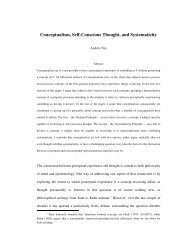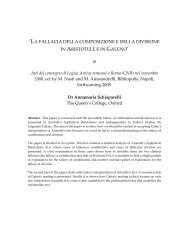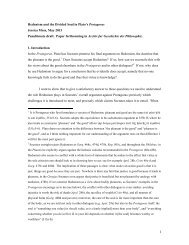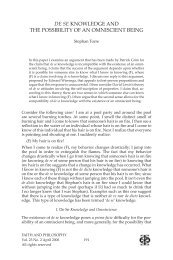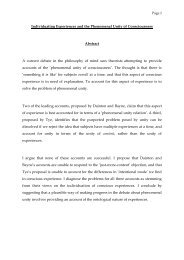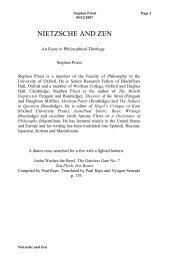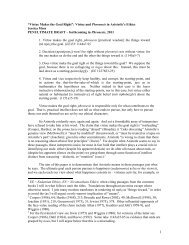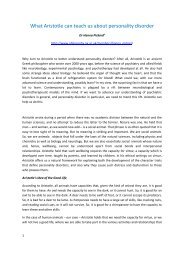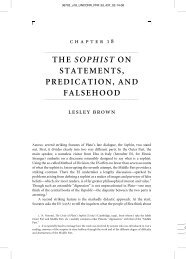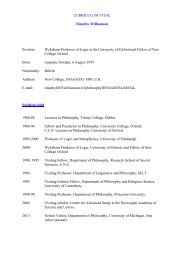In 'Assertion', Robert Stalnaker distinguishes between the sema
In 'Assertion', Robert Stalnaker distinguishes between the sema
In 'Assertion', Robert Stalnaker distinguishes between the sema
Create successful ePaper yourself
Turn your PDF publications into a flip-book with our unique Google optimized e-Paper software.
fire-<strong>the</strong>oretic information – namely by intersecting <strong>the</strong> assertion with <strong>the</strong> context set.<br />
Never<strong>the</strong>less, our intuitive sense that <strong>the</strong> assertion has itself something to do with fire<br />
ra<strong>the</strong>r than goldfish is blatantly violated.<br />
Ano<strong>the</strong>r option is to drop Default. But it should be clear that this move will not help with<br />
cases that turn on transitivity violation, since in <strong>the</strong>se cases all <strong>the</strong> asserted contents were<br />
non-<strong>sema</strong>ntic, and thus no appeal was made to Default. <strong>In</strong> order to be responsive to <strong>the</strong><br />
arguments, one would need to drop both Default and Don’t Care, instituting a general<br />
policy to superdiagonalize. This proposal would address both symmetry and transitivity<br />
failures. But it is still highly problematic. First, <strong>the</strong> concern that superdiagonal content is<br />
counterintuitive remains. But <strong>the</strong>re is a second, perhaps deeper worry. Superdiagonal<br />
content is constructed out of <strong>sema</strong>ntic content. It thus assumes <strong>the</strong> reality of <strong>sema</strong>ntic<br />
content. But on <strong>the</strong> current proposal, <strong>sema</strong>ntic content is never asserted. It is surely ra<strong>the</strong>r<br />
troubling to insist on <strong>the</strong> reality of <strong>sema</strong>ntic content but detach it altoge<strong>the</strong>r from <strong>the</strong> facts<br />
about what is asserted. 15<br />
§6 Replacing knowledge with presuppositions<br />
One might think that <strong>the</strong> problems that we have been discussing can be solved by<br />
dropping our simplifying assumption that <strong>the</strong> context set is delivered by <strong>the</strong> facts about<br />
what is known. This is particularly pertinent, since <strong>Stalnaker</strong> himself explicitly distances<br />
himself from <strong>the</strong> <strong>the</strong>sis that a world belongs to a context set if and only if it is<br />
incompatible with what is known. He tells us that we regularly assume certain<br />
propositions for <strong>the</strong> purposes of a conversation even though those propositions are not<br />
known. <strong>In</strong> such cases, he wants to treat worlds incompatible with <strong>the</strong> assumptions as<br />
outside <strong>the</strong> context set even if <strong>the</strong>y are compatible with what is known.<br />
The core attitudinal state in <strong>Stalnaker</strong>’s own presentation is that of presupposition. He<br />
does not define it in terms of more primitive ideology. Ra<strong>the</strong>r he takes it to be a<br />
fundamental mental state, constituted ultimately by speakers’ dispositions. The central<br />
15<br />
p. 297.<br />
This objection to dropping Default is supported by <strong>Stalnaker</strong>. See for example <strong>Stalnaker</strong> (2006),<br />
1



